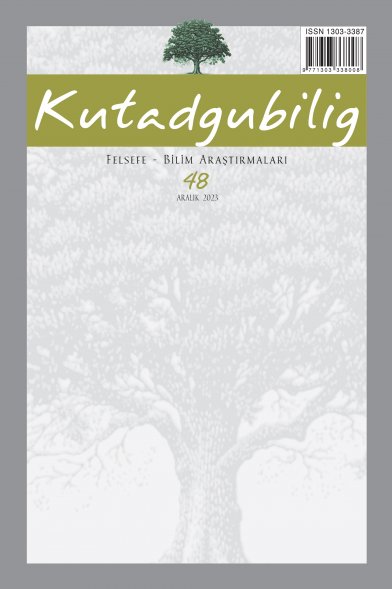CHARLES SANDERS PEIRCE’DE İNANÇ VE KAVRAM
Bu yazı Peirce’ün iki makalesi olan ‘İnancın Sabitleştirilmesi’ ile ‘Kavramları- mızda Açıklık Nasıl Sağlanır?’ makalelerini inceleyerek onun inanç ve kavram mevhumlarını nasıl algıladığını gösterir. ‘İnancın Sabitleştirilmesi’ makalesinde o, verilen öncüllerden başka bir çıkarımdan ziyade belli bir çıkarımı bir zihin alışkanlığı neticesinde elde ettiğimizi söyler. Bu özel zihin alışkanlığı bir öner- mede formüle edilebilir. Bu formülün doğruluğu bu alışkanlığın belirlediği çı- karımların geçerliliğine dayanır. Peirce bu türden bir formüle ‘yol gösterici ilke’ adını verir. O, inanç ve şüphe kavramlarını da inceler. Bir inanç durumu elde etmek için yapılan uğraşa şüphenin rahatsız etmesi neden olur ki o buna ‘araş- tırma’ adını verir. O, inancı sabitleştirmenin dört yolu olduğunu söyler. Bunlar kararlılık yöntemi, otorite yöntemi, a priori yöntem ve bilimsel yöntemdir. O daha sonra her birini inceler ve bilimsel yöntemin en iyi yöntem olduğu sonu- cuna varır. ‘Kavramlarımızda Açıklık nasıl sağlanır?’ makalesinde Descartes ve Leibniz’in görüşlerini eleştirdikten sonra Peirce mantığın bize kavramlarımızı nasıl açık hale getirmemizi öğretmesi gerektiğini ifade eder. O, zihnimizde biri doğrudan bilincinde olduğumuz, diğeri dolaylı olarak bilincinde olduğumuz ol- mak üzere iki tür nesne olduğuna inanır. Peirce bize inancın üç özelliğini verir. Birincisi bizim farkında olduğumuz bir şeydir; ikincisi şüphenin rahatsızlığını giderir; üçüncüsü doğamızda bir alışkanlık tesis eder. Son olarak o bize kavram- ların açıklığının üç derecesi olduğunu söyler. Üçüncü açıklık derecesi pragmatik kural tarafından verilir ki buna göre bir kavramın tüm anlamı onun kavranan sonuçlarında yatar. Peirce bu derece açıklığa sahip bir kavramı mükemmel açık- lıkta bir kavram olarak görür
BELIEF AND IDEA IN CHARLES SANDERS PEIRCE
This paper shows, by analyzing Peirce’s two articles, “The Fixation of Belief” and “How to Make Our Ideas Clear?”, how he perceives the concepts of belief and idea. In “The Fixation of Belief”, he says that from given premises we draw one inference rather than another by some habit of mind. This particular habit of mind may be formulated in a proposition. The truth of the formula depends on the validity of the inferences which the habit determines. Peirce calls sucha formula the ‘guiding principle’ of inference. He also analyzes the notions of belief and doubt. A struggle to attain a state of belief is caused by the irritation of doubt, which he calls ‘inquiry’. He points out that there are four ways of fixing belief. They are the method of tenacity, the method of authority, the a priori method and the scientific method. He then analyzes each one and concludes that the scientific method is the best method. In “How to Make Our Ideas Clear?”, after criticizing the views of Descartes and Leibniz, Peirce states that logic should teach us how to make our ideas clear. Peirce believes that there are two kinds of objects in our consciousness, one being what we are immediately conscious of and the other being what we are mediately conscious of. Peirce gives us three properties of belief. First, it is something that we are aware of; second, it appeases the irritation of doubt; third, it establishes a habit in our nature. Finally, he tells us that there are three degrees of clearness of ideas. The third degree of clearness is given by the pragmatic maxim according to which the whole conception of an idea lies in its conceived effect. Peirce considers an idea with this degree of clearness a perfectly clear one.
___
- Ayer, A. J.; The Origins of Pragmatism, MacMillan, London, 1968.
- Buchler, J.; Philosophical Writings of Peirce, Dover Publications, New York, 1955. De Waal, C.; On Peirce, Wadsworth, United States, 2001.
- Gallie, W. B.; Peirce and Pragmatism, Penguin Books, Middlesex, 1952.
- Houser, N.; Kloesel, C. ed., The Essential Peirce, Vol. I, Indiana University Press, Bloomin- gton, 1992.
- Menand, L. ed.; Pragmatism, Vintage Books, New York, 1997.
- Mısak, C. ed.; The Cambridge Companion to Peirce, Cambridge University Press, Cambrid- ge, 2004.
- Peirce, C. S.; Collected Papers of Charles Sanders Peirce, Vol. V-VI, Harvard University Press, Cambridge, 1960.
- Peirce, C. S.; Pragmatism as a Principle and Method of Right Thinking, ed. Patricia Ann Turrisi, State University of New York Press, Albany, 1997.
- Peirce, C. S.; James, W., Dewey, J., Pragmatizm: Pratik Bir Felsefe, Seçme Yazılar, der. ve çev. Çelik,S. , Doruk Yayımcılık, Istanbul, 2008.
- ISSN: 1303-3387
- Yayın Aralığı: Yılda 2 Sayı
- Başlangıç: 2002
- Yayıncı: Dergah Yayınları A.Ş.
